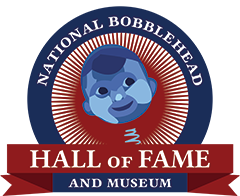From Toronto Star –
Call them nodders, bobbers or bobbleheads. The fact is they are the hottest marketing ploy in major league baseball.
And the Toronto Blue Jays won’t have them until next season at the earliest.
Just how hot are these hand-painted, ceramic figurines with the oversized, bouncy heads?
In Minnesota, home of the cellar-dwelling Twins, bobblehead giveaways at four games this season had fans lining up 14 hours early to nab one of the dolls.
In fact, just before a recent Blue Jays-Twins game at the Metrodome, legendary Twins pitcher Frank Viola strolled alone and unbothered past thousands of fans who only had eyes for bobbleheads.
“We wanted to bring back nostalgic promotions that hadn’t been done in a few years,” said Patrick Klinger, the Twins’ marketing director. “I think we were shocked and amazed.”
The Twins’ average attendance this season is 14,000. More than 20,000 fans were in the stands for each of the bobblehead giveaway games.
“We expected big things out of the promotion, but I don’t think we realized it would be as big as it became,” said Klinger.
Other teams have taken note.
The Mets ordered Tom Seaver dolls from the same maker, and the Pirates handed out Bill Mazeroski bobbleheads in July.
The NHL’s Pittsburgh Penguins and Anaheim Mighty Ducks, the NBA’s Minnesota Timberwolves and other teams are considering the dolls, said Malcolm Alexander, chief executive of Alexander Global Promotions in Bellevue, Wash., which has made the dolls for several pro teams.
Just minutes after 10,000 Kirby Puckett dolls were distributed in Minnesota, some bobber-less fans started offering $200 (U.S.) for the dolls. In the following days, roughly 50 postings appeared on the on-line marketplace eBay offering Minnesota bobbleheads, with the complete set of four – Harmon Killebrew, Kent Hrbek, Tony Oliva and Puckett – requiring a minimum opening bid of $750.
“We would much prefer that they would go home with people than sell on eBay or the Internet, but it’s something we can’t control,” Klinger said.
“We knew after the first giveaway (that some would be sold) by the amount of commerce going around the stadium.”
The original bobbleheads were made of papier mache, then plastic before the current painted ceramic.
The cuteness quotient of the dolls is undeniable, with their intricately painted, goofy frames and grinning faces. But they’re also a higher-quality item than the usual keychains, plastic batting helmets and posters that are staples of ballpark giveaways.
Made of synthetic ceramic, they weigh roughly 1.5 kilograms and stand about 18 centimetres tall. The Twins paid about $5 (U.S.)for each doll, a dollar more than it costs for some tickets to get into the Metrodome.
The dolls, which were common toys about 40 years ago, resurfaced in baseball last season when the San Francisco Giants distributed 30,000 Willie Mays bobbleheads to celebrate their last season in Candlestick Park.
“It was overwhelming,” said Valerie McGuire, the Giants’ promotions manager. “We got so many calls after with people wanting them.
“It’s definitely one of the most, if not the most, successful promotion in Giants history.”
The last time sports bobbers were big in Canada was in the mid-’60’s. Toronto Blue Jays promotions director Peter Cosentino even remembers a Tiger-Cat mascot bobblehead that `danced’ in the back window of the car owned by his father Frank, a Hamilton player from 1960-’66. As far as the Jays go, Toronto has given away calenders, caps and cards – but no bobbleheads . . . at least for now.
“We’ve talked about it but there’s not enough time to produce (a doll) for this year,” said Cosentino. “The club’s 25th anniversary is coming up and we’ve thought about maybe incorporating thebobblehead somehow.”
